Seasonal and Spatial Variability of Atmospheric Emissions from Shipping along the Northern Sea Route
Abstract
:1. Introduction
2. The Northern Sea Route (NSR)
3. Materials and Methods
3.1. Data Collection
3.1.1. Ship Data
3.1.2. Emission Data
3.2. Data Processing and Analysis
4. Results
4.1. Seasonal and Spatial Variations in Ship Traffic
4.2. Seasonal and Spatial Variations of Atmospheric Emissions
5. Discussion
5.1. Seasonal and Spatial Variation in Ship Traffic
5.2. Seasonal Variations in Ship-Associated Emissions
5.3. Implications for the Future
6. Conclusions
Supplementary Materials
Author Contributions
Funding
Institutional Review Board Statement
Informed Consent Statement
Data Availability Statement
Acknowledgments
Conflicts of Interest
References
- Yumashev, D.; van Hussen, K.; Gille, J.; Whiteman, G. Towards a Balanced View of Arctic Shipping: Estimating Economic Impacts of Emissions from Increased Traffic on the Northern Sea Route. Clim. Change 2017, 143, 143–155. [Google Scholar] [CrossRef] [Green Version]
- Dawson, J.; Carter, N.; van Luijk, N.; Parker, C.; Weber, M.; Cook, A.; Grey, K.; Provencher, J. Infusing Inuit and Local Knowledge into the Low Impact Shipping Corridors: An Adaptation to Increased Shipping Activity and Climate Change in Arctic Canada. Environ. Sci. Policy 2020, 105, 19–36. [Google Scholar] [CrossRef]
- PAME. The Increase in Arctic Shipping—Arctic Shipping Status Report #1; PAME: Akureyri, Iceland, 2020. [Google Scholar]
- Berkman, P.A.; Fiske, G.; Røyset, J.-A.; Brigham, L.W.; Lorenzini, D. Next-Generation Arctic Marine Shipping Assessments. In Governing Arctic Seas: Regional Lessons from the Bering Strait and Barents Sea, 1st ed.; Young, O., Berkman, P., Vylegzhanin, A., Eds.; Springer Nature: Cham, Switzerland, 2018. [Google Scholar] [CrossRef]
- Aksenov, Y.; Popova, E.E.; Yool, A.; Nurser, A.J.G.; Williams, T.D.; Bertino, L.; Bergh, J. On the Future Navigability of Arctic Sea Routes: High-Resolution Projections of the Arctic Ocean and Sea Ice. Mar. Policy 2017, 75, 300–317. [Google Scholar] [CrossRef] [Green Version]
- Khon, V.C.; Mokhov, I.I.; Semenov, V.A. Transit Navigation through Northern Sea Route from Satellite Data and CMIP5 Simulations. Environ. Res. Lett. 2017, 12, 024010. [Google Scholar] [CrossRef] [Green Version]
- Melia, N.; Haines, K.; Hawkins, E.; Day, J.J. Towards Seasonal Arctic Shipping Route Predictions. Environ. Res. Lett. 2017, 12, 084005. [Google Scholar] [CrossRef]
- Stephenson, S.R.; Wang, W.; Zender, C.S.; Wang, H.; Davis, S.J.; Rasch, P.J. Climatic Responses to Future Trans-Arctic Shipping. Geophys. Res. Lett. 2018, 45, 9898–9908. [Google Scholar] [CrossRef]
- DNV. HFO in the Arctic—Phase 2; Klima-og Forurensningsdirektoratet: Oslo, Norway, 2013. [Google Scholar]
- DNV GL. Alternative Fuels in the Arctic; PAME: Haugesund, Norway, 2019. [Google Scholar]
- IMO. Fourth IMO GHG Study; IMO: London, UK, 2020. [Google Scholar]
- Corbett, J.J.; Lack, D.A.; Winebrake, J.J.; Harder, S.; Silberman, J.A.; Gold, M. Arctic Shipping Emissions Inventories and Future Scenarios. Atmos. Chem. Phys. 2010, 10, 9689–9704. [Google Scholar] [CrossRef] [Green Version]
- European Environment Agency. The Impact of International Shipping on European Air Quality and Climate Forcing; European Environment Agency: Copenhagen, Denmark, 2013. [Google Scholar] [CrossRef]
- Eyring, V.; Isaksen, I.S.A.; Berntsen, T.; Collins, W.J.; Corbett, J.J.; Endresen, O.; Grainger, R.G.; Moldanova, J.; Schlager, H.; Stevenson, D.S. Transport Impacts on Atmosphere and Climate: Shipping. Atmos. Environ. 2010, 44, 4735–4771. [Google Scholar] [CrossRef]
- Marelle, L.; Thomas, J.L.; Raut, J.C.; Law, K.S.; Jalkanen, J.P.; Johansson, L.; Roiger, A.; Schlager, H.; Kim, J.; Reiter, A.; et al. Air Quality and Radiative Impacts of Arctic Shipping Emissions in the Summertime in Northern Norway: From the Local to the Regional Scale. Atmos. Chem. Phys. 2016, 4, 2359–2379. [Google Scholar] [CrossRef] [Green Version]
- Schröder, C.; Reimer, N.; Jochmann, P. Environmental Impact of Exhaust Emissions by Arctic Shipping. Ambio 2017, 46, 400–409. [Google Scholar] [CrossRef] [Green Version]
- Sharafian, A.; Blomerus, P.; Mérida, W. Natural Gas as a Ship Fuel: Assessment of Greenhouse Gas and Air Pollutant Reduction Potential. Energy Policy 2019, 131, 332–346. [Google Scholar] [CrossRef]
- Eckhardt, S.; Hermansen, O.; Grythe, H.; Fiebig, M.; Stebel, K.; Cassiani, M.; Baecklund, A.; Stohl, A. The Influence of Cruise Ship Emissions on Air Pollution in Svalbard—A Harbinger of a More Polluted Arctic? Atmos. Chem. Phys. 2013, 13, 8401–8409. [Google Scholar] [CrossRef] [Green Version]
- Schmale, J.; Arnold, S.R.; Law, K.S.; Thorp, T.; Anenberg, S.; Simpson, W.R.; Mao, J.; Pratt, K.A. Local Arctic Air Pollution: A Neglected but Serious Problem. Earth Future 2018, 6, 1385–1412. [Google Scholar] [CrossRef]
- Eguíluz, V.M.; Fernández-Gracia, J.; Irigoien, X.; Duarte, C.M. A Quantitative Assessment of Arctic Shipping in 2010–2014. Sci. Rep. 2016, 6, 30682. [Google Scholar] [CrossRef] [PubMed] [Green Version]
- Gunnarsson, B. Recent Ship Traffic and Developing Shipping Trends on the Northern Sea Route—Policy Implications for Future Arctic Shipping. Mar. Policy 2021, 124, 104369. [Google Scholar] [CrossRef]
- Bencs, L.; Horemans, B.; Buczyńska, A.J.; Deutsch, F.; Degraeuwe, B.; Van Poppel, M.; Van Grieken, R. Seasonality of Ship Emission Related Atmospheric Pollution over Coastal and Open Waters of the North Sea. Atmos. Environ. X 2020, 7, 100077. [Google Scholar] [CrossRef]
- Winther, M.; Christensen, J.H.; Plejdrup, M.S.; Ravn, E.S.; Eriksson, Ó.F.; Kristensen, H.O. Emission Inventories for Ships in the Arctic Based on Satellite Sampled AIS Data. Atmos. Environ. 2014, 91, 1–14. [Google Scholar] [CrossRef]
- Winther, M.; Christensen, J.H.; Angelidis, I.; Ravn, E.S. Emissions from Shipping in the Arctic from 2012–2016 and Emissions Projections for 2020, 2030 and 2050; Aarhus University; DCE—Danish Centre for Environment and Energy: Aarhus, Denmark, 2017. [Google Scholar]
- Jalkanen, J.P.; Johansson, L.; Kukkonen, J.; Brink, A.; Kalli, J.; Stipa, T. Extension of an Assessment Model of Ship Traffic Exhaust Emissions for Particulate Matter and Carbon Monoxide. Atmos. Chem. Phys. 2012, 12, 2641–2659. [Google Scholar] [CrossRef] [Green Version]
- Dalsøren, S.B.; Eide, M.S.; Endresen, O.; Mjelde, A.; Gravir, G.; Isaksen, I.S.A. Update on Emissions and Environmental Impacts from the International Fleet of Ships: The Contribution from Major Ship Types and Ports. Atmos. Chem. Phys. 2009, 9, 2171–2194. [Google Scholar] [CrossRef] [Green Version]
- Ødemark, K.; Dalsøren, S.B.; Samset, B.H.; Berntsen, T.K.; Fuglestvedt, J.S.; Myhre, G. Short-Lived Climate Forcers from Current Shipping and Petroleum Activities in the Arctic. Atmos. Chem. Phys. 2012, 12, 1979–1993. [Google Scholar] [CrossRef] [Green Version]
- Marelle, L.; Raut, J.C.; Law, K.S.; Duclaux, O. Current and Future Arctic Aerosols and Ozone from Remote Emissions and Emerging Local Sources—Modeled Source Contributions and Radiative Effects. J. Geophys. Res. Atmos. 2018, 123, 12942–12963. [Google Scholar] [CrossRef]
- Moe, A.; Schram Stokke, O. Asian Countries and Arctic Shipping: Policies, Interests and Footprints on Governance. Arct. Rev. Law Polit. 2019, 10, 24–52. [Google Scholar] [CrossRef] [Green Version]
- Liu, M.; Kronbak, J. The Potential Economic Viability of Using the Northern Sea Route (NSR) as an Alternative Route between Asia and Europe. J. Transp. Geogr. 2010, 18, 434–444. [Google Scholar] [CrossRef]
- Lindstad, H.; Bright, R.M.; Strømman, A.H. Economic Savings Linked to Future Arctic Shipping Trade Are at Odds with Climate Change Mitigation. Transp. Policy 2016, 45, 24–30. [Google Scholar] [CrossRef] [Green Version]
- Stephenson, S.R.; Brigham, L.W.; Smith, L.C. Marine Accessibility along Russia’s Northern Sea Route. Polar Geogr. 2014, 37, 111–133. [Google Scholar] [CrossRef]
- Ørts Hansen, C.; Grønsedt, P.; Lindstrøm Graversen, C.; Hendriksen, C. Arctic Shipping—Commercial Opportunities and Challenges; CBS Maritime: Frederiksberg, Denmark, 2016. [Google Scholar]
- Gunnarsson, B.; Moe, A. Ten Years of International Shipping on the Northern Sea Route: Trends and Challenges. Arct. Rev. Law Polit. 2021, 12, 4–30. [Google Scholar] [CrossRef]
- Humpert, M. Arctic Shipping: An Analysis of the 2013 Northern Sea Route Season; The Arctic Insitute: Washington, DC, USA, 2014. [Google Scholar]
- The Northern Sea Route Information Office. About 23 Million Tons Transported along NSR in 9 Months of 2020. Available online: https://arctic-lio.com/about-23-million-tons-transported-along-nsr-in-9-months-of-2020/ (accessed on 8 October 2021).
- PAME. ASTD Data Document. Available online: https://pame.is/images/03_Projects/ASTD/Documents/ASTD_data/ASTD_Data_20_March.pdf (accessed on 14 November 2021).
- Silber, G.K.; Adams, J.D. Vessel Operations in the Arctic, 2015–2017. Front. Mar. Sci. 2019, 6, 573. [Google Scholar] [CrossRef]
- Stocker, A.N.; Renner, A.H.H.; Knol-Kauffman, M. Sea Ice Variability and Maritime Activity around Svalbard in the Period 2012–2019. Sci. Rep. 2020, 10, 17043. [Google Scholar] [CrossRef]
- PAME. Access to the Arctic Ship Traffic Data System. Available online: https://pame.is/images/03_Projects/ASTD/Documents/ASTD_Access/Access_to_ASTD.pdf (accessed on 14 November 2021).
- PAME. ASTD Data Document. Available online: https://pame.is/images/03_Projects/ASTD/Documents/ASTD_data/ASTD_Data_v1.4_June_2021.pdf (accessed on 14 November 2021).
- Fetterer, F.; Knowles, K.; Meier, W.N.; Savoie, M.; Windnagel, A.K. Sea Ice Index, version 3: Sea ice extent; NSIDC: Boulder, CO, USA. Available online: https://nsidc.org/data/G02135/versions/3 (accessed on 23 November 2021).
- Stephenson, S.R.; Smith, L.C.; Brigham, L.W.; Agnew, J.A. Projected 21st-Century Changes to Arctic Marine Access. Clim. Change 2013, 118, 885–899. [Google Scholar] [CrossRef] [Green Version]
- Stephenson, S.R.; Smith, L.C. Influence of Climate Model Variability on Projected Arctic Shipping Futures. Earth Future 2015, 3, 331–343. [Google Scholar] [CrossRef] [Green Version]
- Bennett, M.M.; Stephenson, S.R.; Yang, K.; Bravo, M.T.; De Jonghe, B. The Opening of the Transpolar Sea Route: Logistical, Geopolitical, Environmental, and Socioeconomic Impacts. Mar. Policy 2020, 121, 104178. [Google Scholar] [CrossRef]
- Olmer, N.; Comer, B.; Roy, B.; Mao, X.; Rutherford, D. Greenhouse Gas Emissions From Global Shipping, 2013–2015; The International Council on Clean Transportation: Washington, DC, USA, 2017. [Google Scholar]
- Simonsen, M.; Walnum, H.J.; Gössling, S. Model for Estimation of Fuel Consumption of Cruise Ships. Energies 2018, 11, 1059. [Google Scholar] [CrossRef] [Green Version]
- Simonsen, M. Cruise Ship Tourism—A LCA Analysis; Western Norway Research Institution: Sogndal, Norway, 2014. [Google Scholar]
- Comer, B.; Osipova, L.; Georgeff, E.; Mao, X. The International Maritime Organization’s Proposed Arctic Heavy Fuel Oil Ban: Likely Implications and Opportunities for Improvement; The International Council on Clean Transportation: Washington, DC, USA, 2020. [Google Scholar]
- Comer, B.; Olmer, N.; Mao, X.; Roy, B.; Rutherford, D. Prevalence of Heavy Fuel Oil and Black Carbon in Arctic Shipping, 2015 to 2025; The International Council on Clean Transportation: Washington, DC, USA, 2017. [Google Scholar]
- Cohen, J.; Zhang, X.; Francis, J.; Jung, T.; Kwok, R.; Overland, J.; Ballinger, T.J.; Bhatt, U.S.; Chen, H.W.; Coumou, D.; et al. Divergent Consensuses on Arctic Amplification Influence on Midlatitude Severe Winter Weather. Nat. Clim. Chang. 2020, 10, 20–29. [Google Scholar] [CrossRef]
- SIMIP, C. Arctic Sea Ice in CMIP6. Geophys. Res. Lett. 2020, 47, e2019GL086749. [Google Scholar] [CrossRef]
- Smith, D.M.; Screen, J.A.; Deser, C.; Cohen, J.; Fyfe, J.C.; García-Serrano, J.; Jung, T.; Kattsov, V.; Matei, D.; Msadek, R.; et al. The Polar Amplification Model Intercomparison Project (PAMIP) Contribution to CMIP6: Investigating the Causes and Consequences of Polar Amplification. Geosci. Model Dev. 2019, 12, 1139–1164. [Google Scholar] [CrossRef] [Green Version]
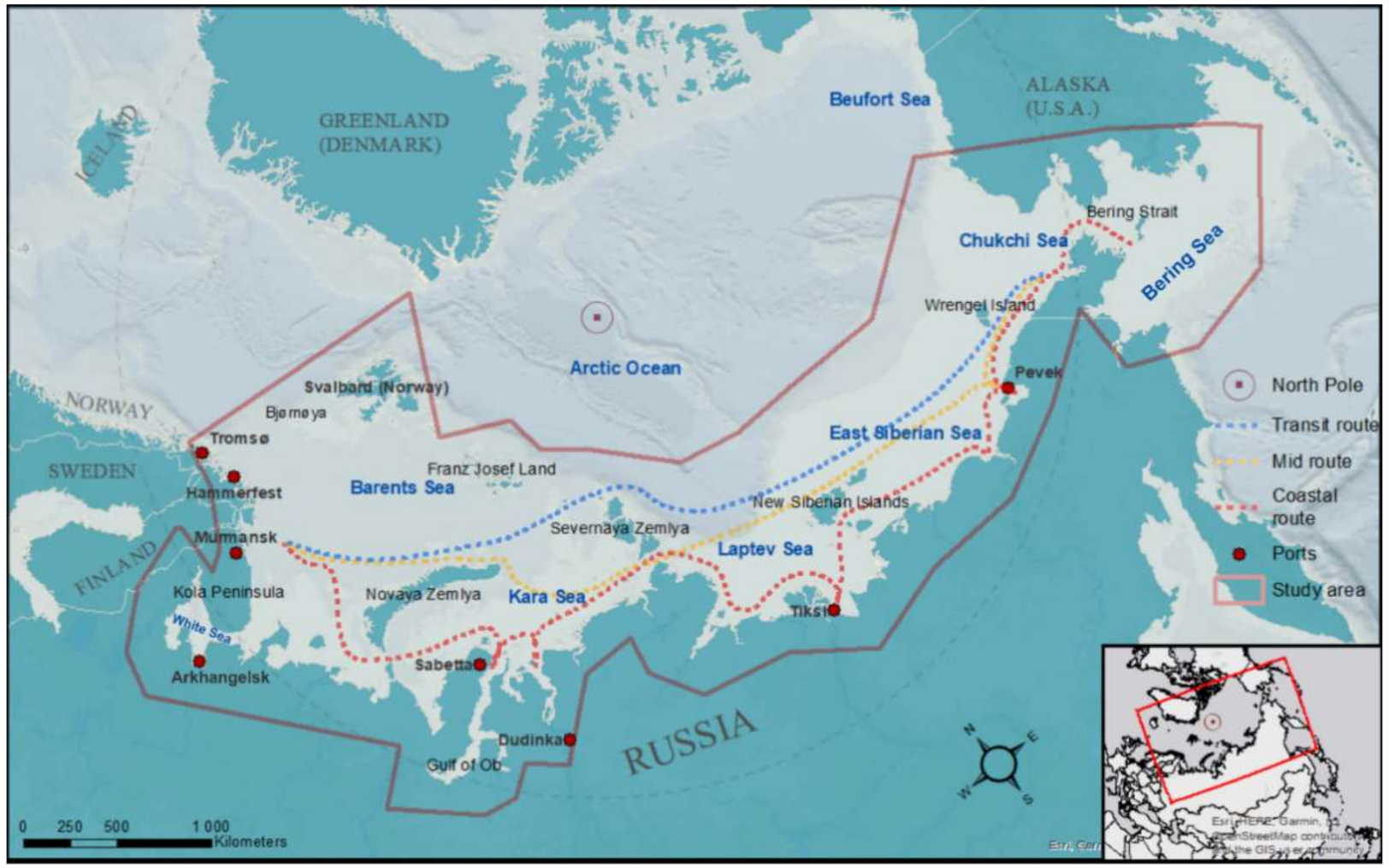
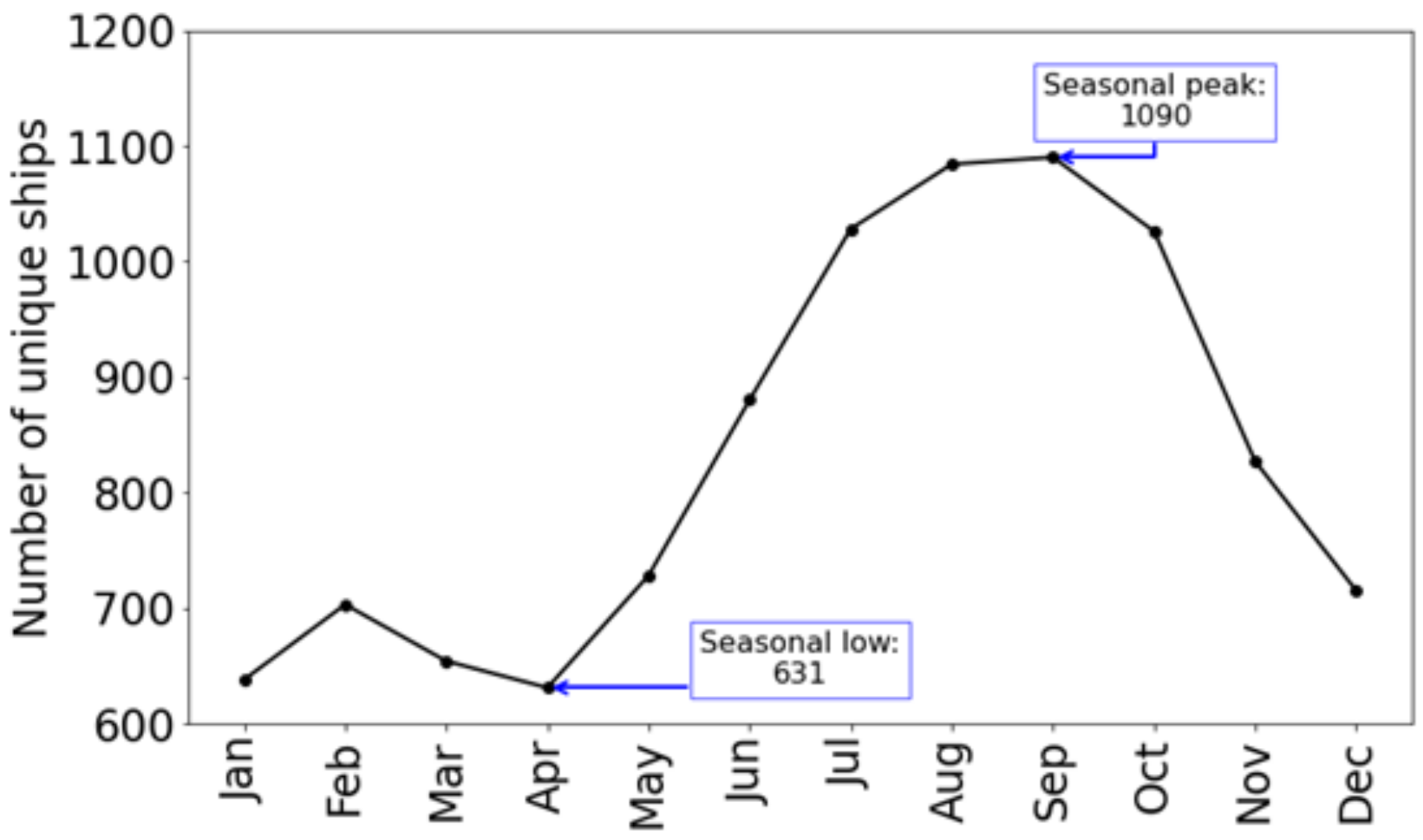
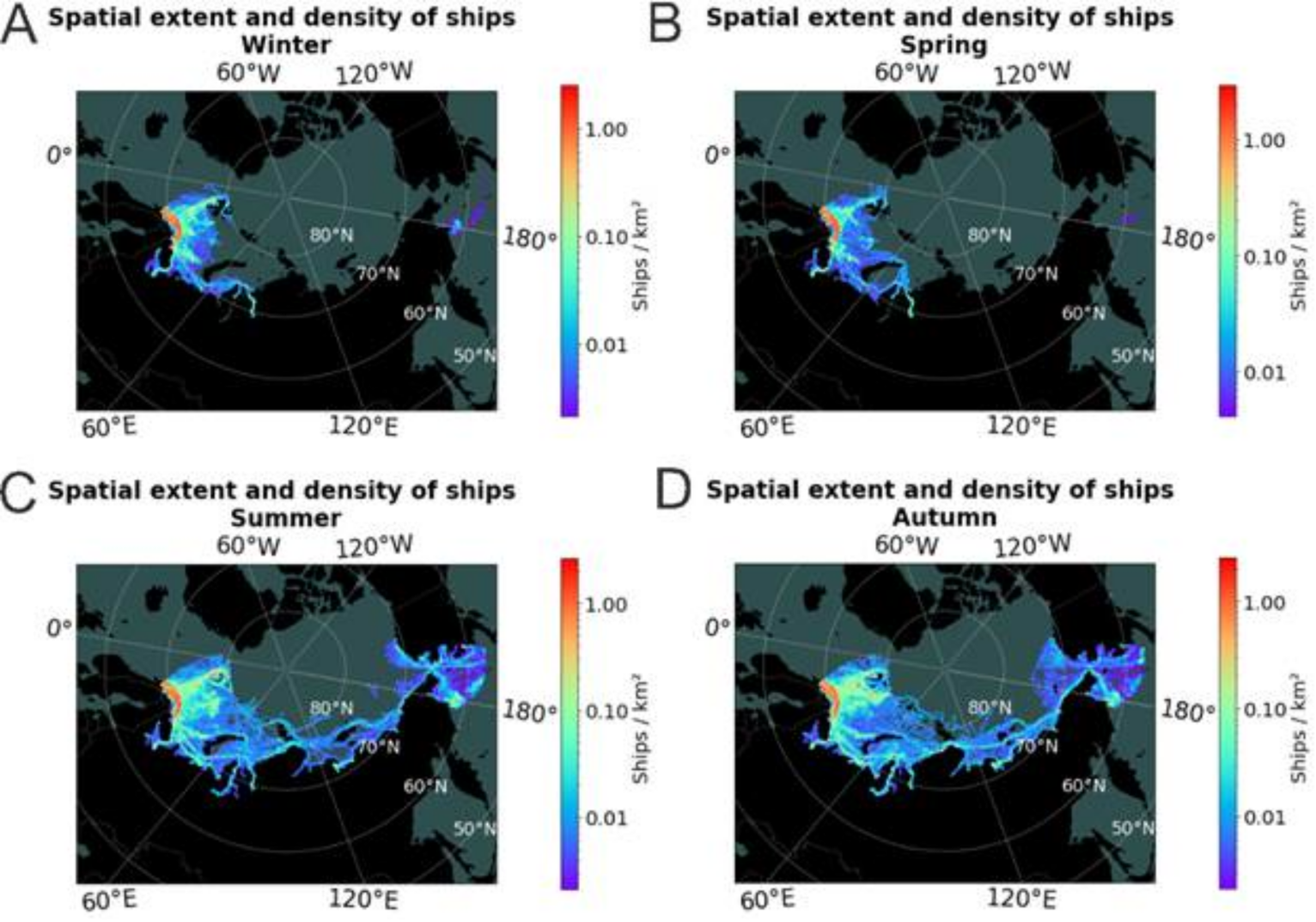
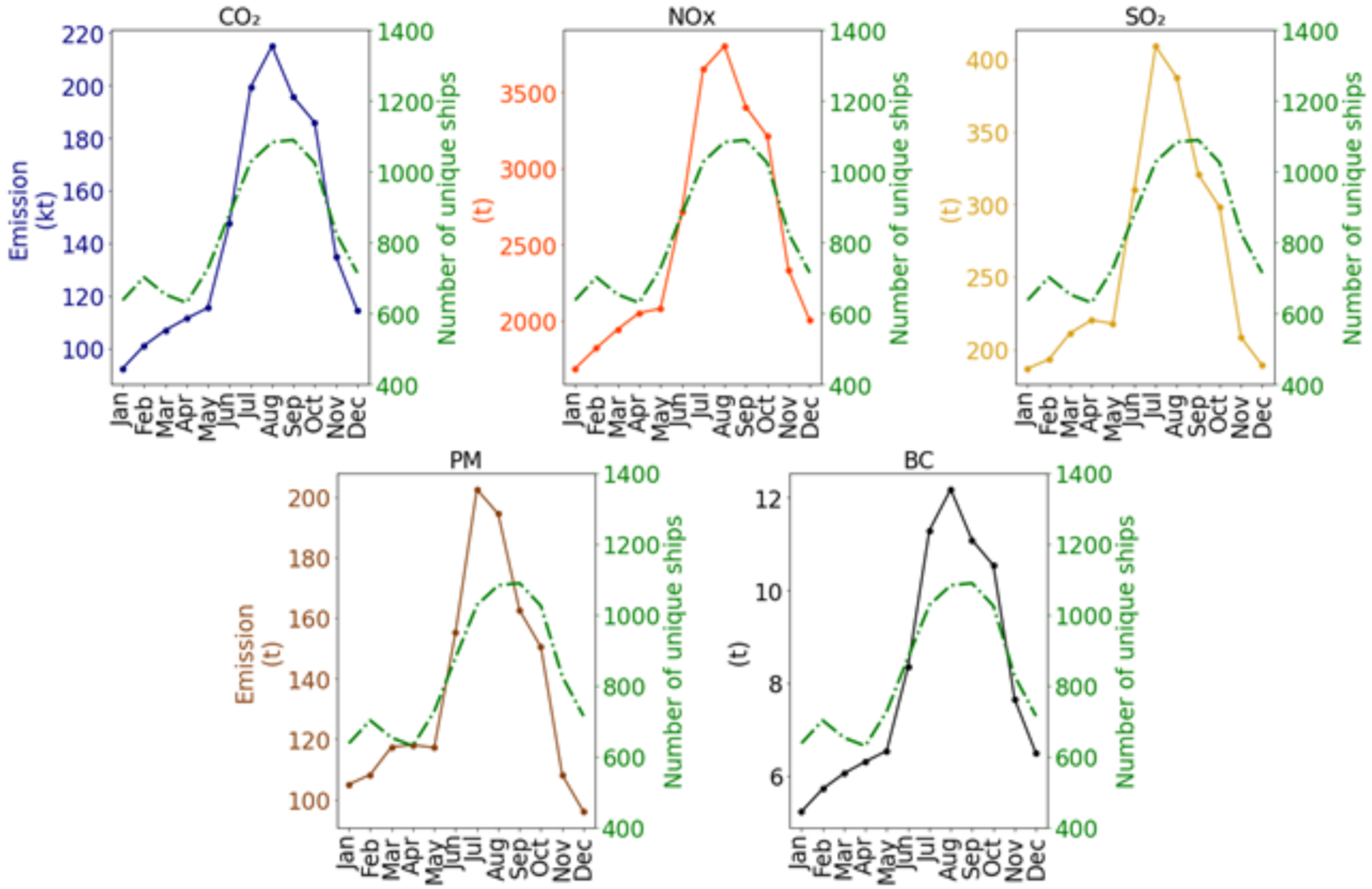

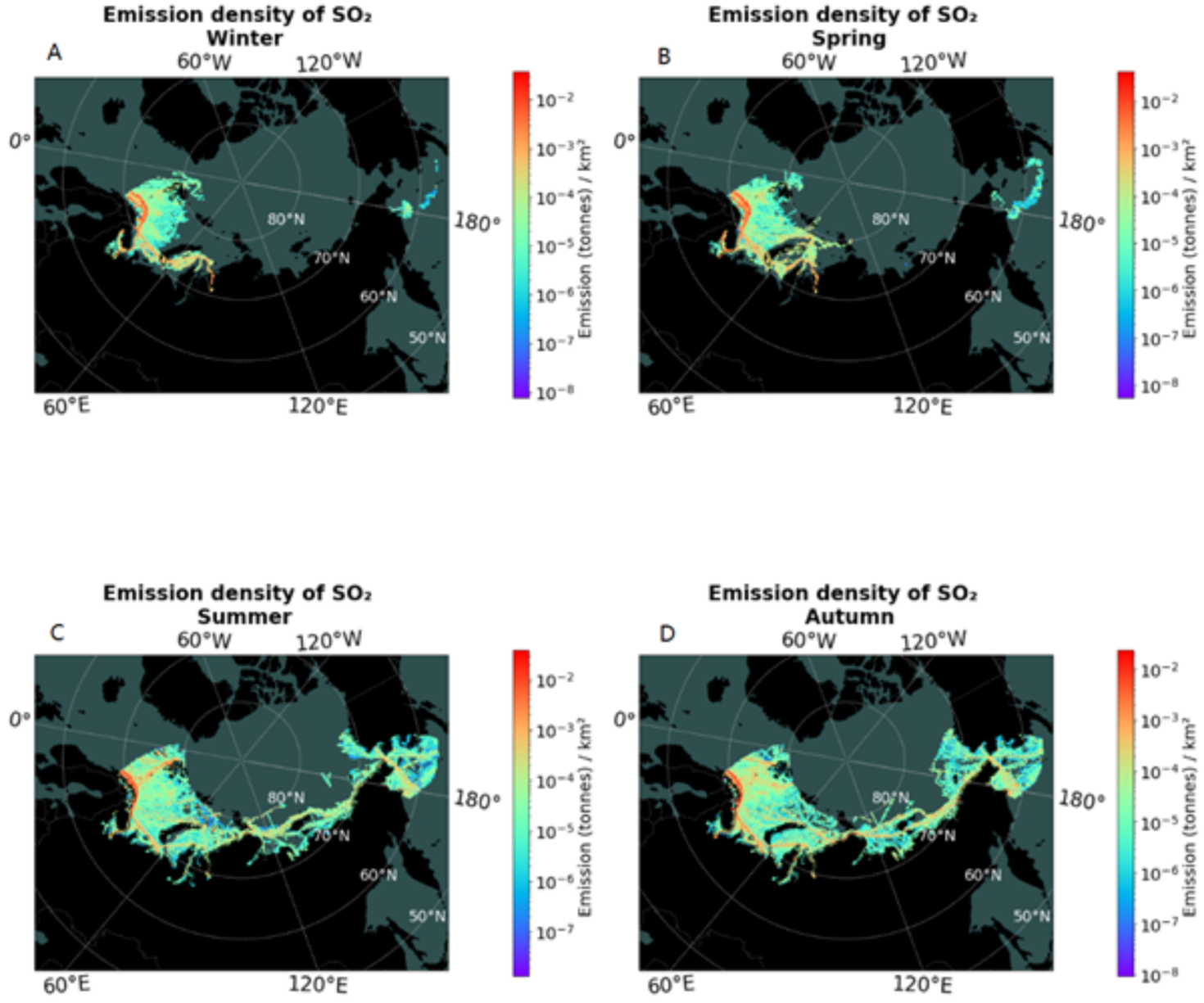

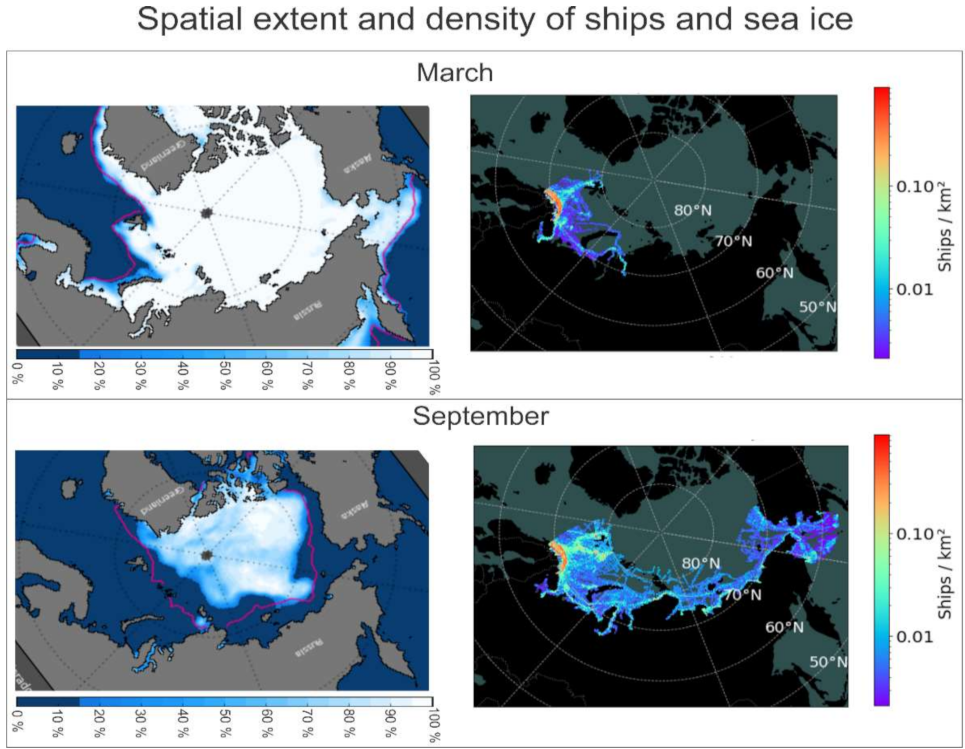
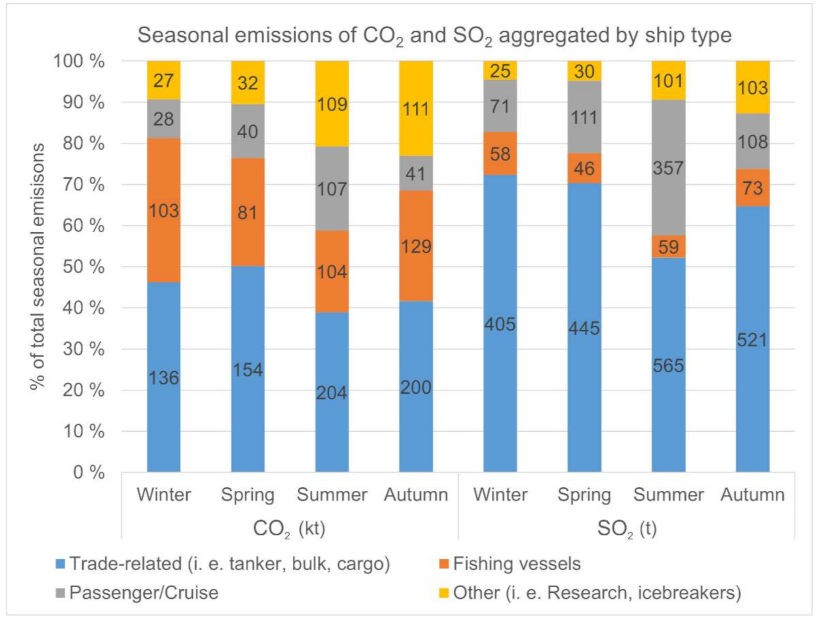
| Jan | Feb | Mar | Apr | May | Jun | Jul | Aug | Sep | Oct | Nov | Dec |
|---|---|---|---|---|---|---|---|---|---|---|---|
| Winter | Spring | Summer | Autumn | Winter | |||||||
Publisher’s Note: MDPI stays neutral with regard to jurisdictional claims in published maps and institutional affiliations. |
© 2022 by the authors. Licensee MDPI, Basel, Switzerland. This article is an open access article distributed under the terms and conditions of the Creative Commons Attribution (CC BY) license (https://creativecommons.org/licenses/by/4.0/).
Share and Cite
Figenschau, N.; Lu, J. Seasonal and Spatial Variability of Atmospheric Emissions from Shipping along the Northern Sea Route. Sustainability 2022, 14, 1359. https://doi.org/10.3390/su14031359
Figenschau N, Lu J. Seasonal and Spatial Variability of Atmospheric Emissions from Shipping along the Northern Sea Route. Sustainability. 2022; 14(3):1359. https://doi.org/10.3390/su14031359
Chicago/Turabian StyleFigenschau, Nikolai, and Jinmei Lu. 2022. "Seasonal and Spatial Variability of Atmospheric Emissions from Shipping along the Northern Sea Route" Sustainability 14, no. 3: 1359. https://doi.org/10.3390/su14031359
APA StyleFigenschau, N., & Lu, J. (2022). Seasonal and Spatial Variability of Atmospheric Emissions from Shipping along the Northern Sea Route. Sustainability, 14(3), 1359. https://doi.org/10.3390/su14031359






